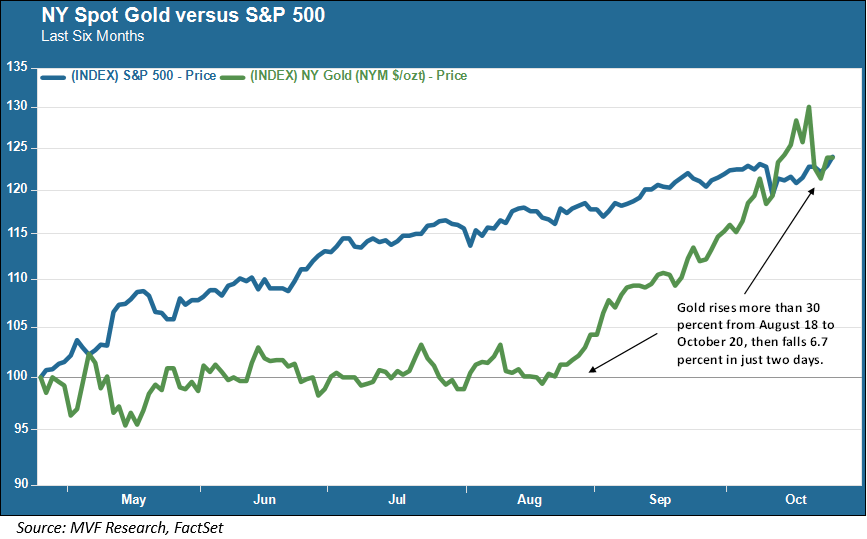
It has been a strange year in so many ways, but one of this year’s odder bedfellows has been the tandem duo of US stocks and gold. These two asset classes don’t normally tango together. In 1979, gold was just about the only thing that was working for portfolios, while the S&P 500 was in the dumps and bond markets were roiled by the Volcker shock of ultra-tight monetary policy. Two decades later, 1999 was a go-go year for any stock with even the flimsiest connection to the Internet, while gold had nothing to offer other than being pretty to look at.
This year, the precious metal and the blue chip stock index have been at the forefront of a giddy general melt-up for financial assets. Gold, in particular, has been on a tear since late summer, shooting up by more than 30 percent from the middle of August to the end of last week. But this week, suddenly, things went south and the price of gold dropped by nearly seven percent in just two days, no doubt to the chagrin of those coming late to the party.

To Hedge or Not to Hedge
The timing of this pullback was a little odd. As we wrote about in our column last week, all the talk of the town in recent days has been about a stock market bubble. Bubble talk, in general, gets people to start thinking about hedging. Gold, of course, has long been thought of as a go-to hedge asset – witness that start turn during the stagflation miasma of the late 1970s. One might have thought, rationally, that this week would kick off with a big pullback in stocks while gold rose some more. But rationality has precious little to do with the ways of the markets in these times of ours. Stocks have continued blithely to ignore anyone waving wildly at stratospheric valuation levels, surging to yet another record high by the end of the week.
It is entirely possible, of course, that gold’s performance this year doesn’t actually have all that much to do with hedging. There are other, potentially cheaper ways to offset exposure to US stocks if one is so inclined, including simple S&P 500 put options. Capital markets are starting to look a lot more like prop bets than anything else, where you can take a position for or against just about any movement large or small in just about any corner of the globe using an ever-expanding arsenal of easy-to-obtain assets. Maybe there’s nothing more to the post-August rally in gold than the simple fact of all that liquidity coursing around the world has to go somewhere, so a good chunk of it might as well go to something that has been around for thousands of years.
Just a Pretty Hunk of Meta
The other thing to remember about gold is that it has no other source of value than price appreciation. No interest coupons, no dividend payments, nothing other than a belief that the price will be higher tomorrow than it is today. Yes, it is a scarce asset with a finite supply, and over long periods of time the scarcity factor delivers value. But not always. Gold rose, for understandable reasons, during and after the stock market crash in 2008, reaching a then-peak in 2011. But prices fell after that, and didn’t regain that 2011 peak price until the middle of 2020. In the post-pandemic period through 2023 gold’s performance was mostly flat. It was no help to investors looking for a hedge during the equity bear market of 2022, with prices falling around 15 percent from April to October of that year (the sharp rise of interest rates during this period made gold, as a non-interest bearing asset, less attractive).
What happens next remains to be seen, of course. Today, stocks are up, gold is down and a belated inflation report (delayed due to the government shutdown) delivered no surprises versus expectations. In the wake of that powerful surge in gold prices from August to last week, though, a more protracted pullback would not be out of the question.